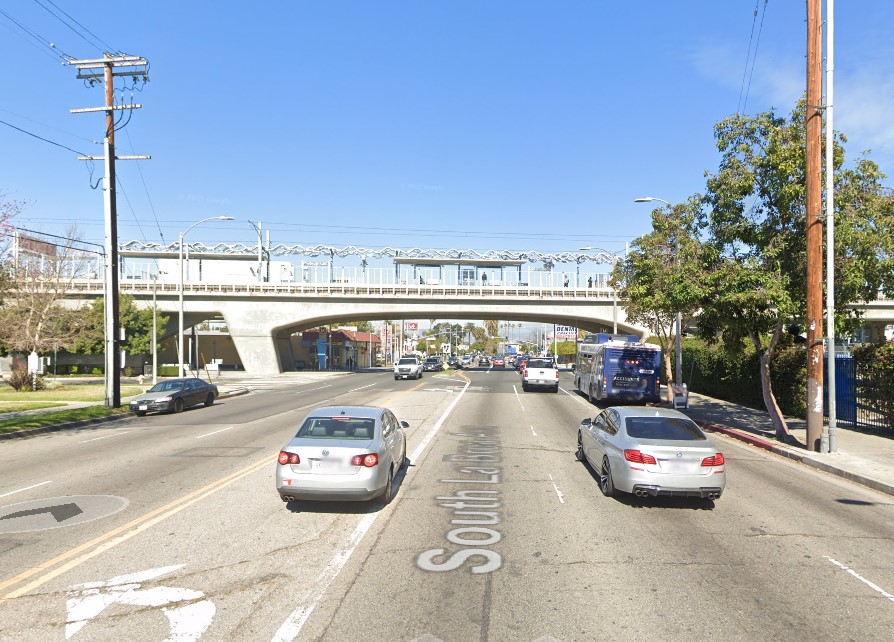This afternoon, the L.A. City Council Transportation Committee approved city staff recommendations for next year's so-called "complete streets" program to improve portions of Culver Boulevard, La Brea Avenue, and Highland Avenue. The program fails to actually implement transit or bikeway components of the approved Mobility Plan - leaving incomplete streets very much incomplete.
LA Transportation Committee will consider next week a proposal to include parts of Culver, La Brea and Highland corridors in the Complete Streets Program with the following scopes. https://t.co/hJV24UCvrc pic.twitter.com/axiJld8Zjh
— Carter Rubin (@CarterRubin) August 13, 2021
The projects approved by the committee include the following stretches: [see additional details in council file 17-0950-S2 and staff report]
- Culver Boulevard from Centinela Avenue to Slauson Avenue
- La Brea Avenue from Coliseum Street to Adams Boulevard (includes the Metro E Line Expo/La Brea Station)
- Highland Avenue from Santa Monica Boulevard to Franklin Avenue (includes the Metro B Line Hollywood/Highland Station)
The project scope includes street resurfacing, curb ramps, sidewalk repair, a few pedestrian islands, and some basic additional features. Some of these - especially fixing sidewalks for first/last mile connections to transit - are much needed. But they fall short of making the streets truly "complete."
At today's committee meeting, Bureau of Engineering staff noted that the locations were chosen because they were on the city's Vision Zero High Injury Network and that improvements "can be implemented without reconfiguring the roadway."
Streets for All had urged its followers to press the committee to implement the La Brea bus-only lanes already approved in the city's Mobility Plan. Councilmembers Mike Bonin and Paul Koretz questioned why the planned bus facilities had not been included in La Brea's preliminary designs. LADOT staff responded that the department tries to "balance the needs" and "our corridors are width-challenged." This portion of La Brea is at least 75-feet wide throughout. The DOT representative stated that a bus lane would "compromise the objective" of this project, but could proceed independently.
Bonin encouraged LADOT to work with the local council office to implement the bus lane, stating that it is a Metro priority and important for equity. Sadly, the directive to work with the local councilmember is tacit acknowledgement that each councilmember has (and frequently uses) veto powers to get in the way of street improvements needed to save lives, and improve transit, health, and quality of life.
Correction 19 August 2021: Streetsblog initially misattributed a Bureau of Engineering staff statement to LADOT staff. This has been fixed. Per email communication from LADOT spokesperson Colin Sweeney:
Beyond the misattribution, your reporting also misses critical context and it seems an understanding of why the Complete Streets program was developed.
The Complete Streets Program was created to implement Vision Zero projects on streets in need of reconstruction. The Bureau of Engineering leads Complete Streets design efforts, determines implementation timeline, and project scope with Vision Zero-related safety improvements and accessibility as a guiding principle. LADOT advises on street design and seeks opportunities within the Complete Streets Program to implement the Mobility Plan, as can be seen in some of the Complete Streets projects that have been completed to date like Avalon where we did a roadway reconfiguration. The Complete Streets Program is not our singular opportunity to deliver these projects. We pursue Mobility Plan goals through a variety of LADOT-led planning, implementation and community engagement efforts. This includes our planning, community outreach, and implementation of dedicated bus lanes, which require a transit-agency partner who can plan for the operational implications of a Bus-Only lane. This is how other shared bus-bike lanes such as 5th & 6th Street and the Alvarado bus-only lane were implemented.
In summary, the Complete Streets program is only one of many ways we pursue mobility plan goals like bus-only lanes, and the program does not preclude the implementation of these efforts either.







